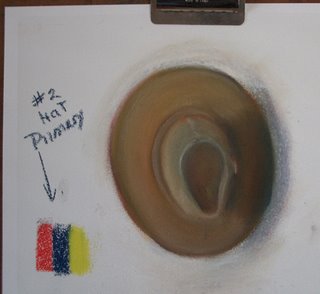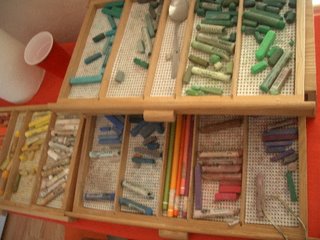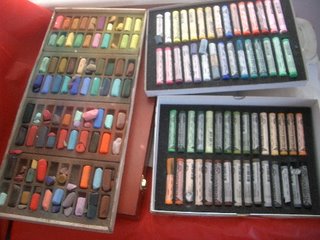

I guess my sketch is what I expected to see. These hunts are helping me to get over that and to 'see' better. It is similar to the roses and rocks for me. That is probably one of the reasons that paintings that leave areas to the imagination are appreciated. The viewer can fill in the blanks to suit their own feelings and imaginations. I love to look at very realistic paintings, as well, but they don't touch the emotions as much for me.
I usually lean toward using primary colors in painting. Especially in oils and acrylics. I have never purchased things like turquoise, peach, etc. I have always liked to mix my own colors. My palette is usually: titanium white, cadmium yellow, yellow ochre, cadmium red, indian red (this doesn't go as pink when white is added and mixed with black makes a great background color when you want it to look black, but have color. Especially in still life paintings.), alizarin crimson, burnt sienna, burnt umber, a blue (depending on still life or landscape), sap green and sometimes ivory black. In studio I add yellow green and thalo green sometimes. For plein air, I usually leave off the indian red, alizarin, and black. But as you see from this exercise, you don't really need many colors to mix your own.
Pastels can be used almost the same way. It is great to have all the colors and not have to blend and cross hatch as much, faster of course. :) But with a limited palette or small number of pastels, one can put black under a brighter color to get a darker version. Recently the manufacturers have been developing more dark colors. Unison and Terry Ludwig have great selections of darks. Pastels have more brilliance if they are not blended too much. The prisms/edges of the pigment reflect the light better. When blended the edges are smoothed and do not reflect as much light. That is a good excuse to buy many pastels ... if you need an excuse. When you add white to pastels it looks a little chalky, so nice to have many light colors as well.
Most pastelists just love to look at all the colors, I think. You can never have too many pastels. I'm including a couple of photos of some of my pastels as a sample. :)




2 comments:
I know they're called primary colors 'cause all the other colors can be made by combining 'em in different ways. But, wow. Brown, tan, and beige just don't seem like something you should be able to get by mixing red, yellow, and blue! Cool.
'Tis fun! I am somewhat amazed that I can usually pull it off as well. :)
Thanks.
Post a Comment